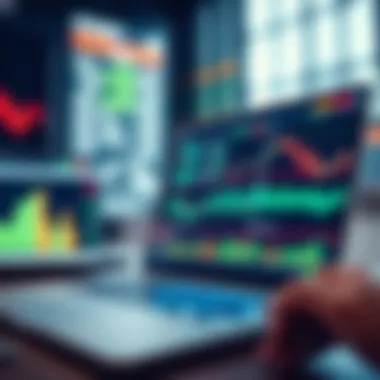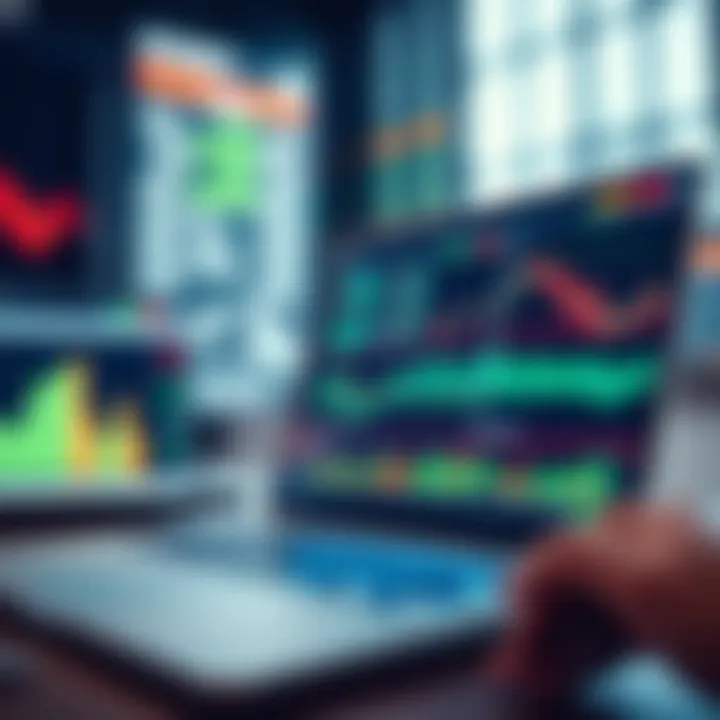Exploring the Advantages of E-Trading for Investors


Intro
In today’s fast-paced financial landscape, electronic trading, commonly known as e-trading, has transformed how investors access the markets. Whether you are a newcomer navigating your first trade or a seasoned investor refining your strategy, understanding the ins and outs of e-trading is essential. This article aims to dissect the myriad benefits of e-trading, reinforcing its relevance in an era where technology and finance intertwine more than ever.
E-trading has broken down barriers, offering unprecedented accessibility to various financial markets. Investors now have the tools to make informed decisions at their fingertips, constantly updated in real-time. Moreover, the efficiency of electronic transactions significantly lowers the costs traditionally associated with stock trading. But what does this mean for investment strategies? This piece will explore how e-trading impacts everything from market transparency to financial literacy, ultimately reshaping how individuals approach investing.
Understanding the strategic insights e-trading provides will help modern investors navigate the complexities of today’s market. This exploration will encompass the current market conditions, investment strategies, and resources available to aid in informed decision-making. So, without further ado, let’s delve deep into the Market Overview.
Prelude to Electronic Trading
In the ever-evolving landscape of finance, electronic trading has become a cornerstone for individual investors and financial institutions alike. The rise of this trading method signals not just a shift in how transactions occur but also a fundamental change in the dynamics of the market. The importance of understanding electronic trading lies in its potential to broaden investment horizons, enhance efficiency, and democratize access to financial markets.
Notably, electronic trading addresses several fundamental aspects of modern investing. For one, it allows participants to engage with the markets in real-time, dismantling barriers previously posed by time and distance. Investors, whether novice or seasoned, can access a wealth of information and market data at their fingertips. This accessibility empowers users to make informed decisions quickly, often leading to a more dynamic trading experience.
Additionally, we see a significant impact on cost structures associated with trading. Traditional brokers often instituted hefty commissions and fees that could eat into profits. However, with e-trading, many investors can benefit from reduced transaction costs, primarily because of lower operational overheads for firms that operate online.
Moreover, understanding the integral elements of electronic trading allows investors to navigate the market's complexities. As trading tools evolve, incorporating advanced technologies into investment strategies becomes increasingly crucial. E-trading platforms now offer features such as algorithmic trading and real-time analytics, which can significantly enhance trading strategies.
In summary, as we delve deeper into how electronic trading reshapes investment strategies and the implications it bears on investor behaviors and market dynamics, readers will find insights that resonate with their own experiences and expectations in the finance universe.
Definition and Overview
At its core, electronic trading refers to the buying and selling of financial instruments via electronic platforms rather than traditional methods such as over-the-counter or through physical exchanges. This method uses sophisticated technology to facilitate transactions in an efficient, rapid manner. Traders connect to marketplaces electronically, providing them with opportunities previously limited to financial professionals.
The key components of electronic trading include:
- Direct Market Access (DMA): A process that blows open the doors of the market, allowing investors to place orders directly on the exchanges without intermediaries.
- Trading Platforms: Software that provides investors with a user-friendly interface to manage their trades, monitor markets, and analyze data.
- Market Makers and Electronic Communication Networks (ECNs): Facilitators that connect buyers and sellers, often enhancing liquidity and pricing.
Through unique trading platforms like TD Ameritrade and Robinhood, this approach has made the market more accessible to a broader audience.
Historical Context
To truly appreciate the enormity of electronic trading today, it helps to take a step back and look at its origins. The concept began gaining traction in the late 20th century when technology started to reshape industries across the globe. Prior to that, trading was primarily conducted on physical exchanges where brokers shouted prices and filled orders manually, a practice fixed in time.
The late 1970s and early 1980s were pivotal. During this period, systems like the NASDAQ introduced forward-thinking electronic systems that began to automate trading activities. Fast forward to the 1990s, and the internet revolutionized the way individuals approached investing. The launch of online brokerage services in this decade heralded a new era where average people could engage with the market from their homes without needing a go-between.
Today, as we bask in the fruits of this evolution, e-trading represents not only a tool for efficiency but also a reflection of broader technological trends that continue to shape investor behaviors and market structures. As this journey continues, understanding the roots of electronic trading will enable investors to fully grasp its trajectory and engage with it confidently.
Accessibility and Convenience
In an era where speed and efficiency govern the financial world, accessibility and convenience in e-trading stand as pivotal landmarks for modern investors. No longer tethered to traditional trading hours or rigid platforms, individuals can engage with the markets at any hour, garnering a significant edge in today’s fast-paced environment. This shift not only optimizes time management but also aligns trading activities with personal schedules, making investing more adaptable and user-friendly for both rookies and seasoned traders alike.
/ Market Access
The round-the-clock nature of e-trading offers a significant advantage: 24/7 market access. Investors can delve into trading whenever the inclination strikes, whether it’s midday or well past midnight. This flexibility is crucial for seizing opportunities that may arise unexpectedly. For instance, significant market news can break at any time, and immediate access allows investors to respond swiftly rather than waiting for a trading session to open.
Moreover, global markets don't adhere to the conventional workday. For those knowledgeable about foreign markets or keen on international stocks, having the ability to bond with diverse market shifts expands horizons. Making trades during quieter hours often leads to advantageous positions or better pricing without the clamor of increased activity often found during peak hours. This facet of e-trading means that serious investors can stay engaged and proactive, keeping their finger on the pulse of market movements.
Online Trading Platforms
The role of online trading platforms in showcasing accessibility and convenience cannot be overstated. These digital arenas serve as gateways, simplifying the entire trading process, from executing orders to monitoring market trends. By providing diverse functionalities, these platforms cater to a wide array of user preferences and strategies.
User Interface and Functionality
A user-friendly interface is integral to the trading experience. When talking about functionality, it's about how the tools are presented and how easily they can be navigated. A clean, intuitive interface encourages traders to engage more routinely and deftly. For example, platforms like MERRILL EDGE enable users to customize their dashboards, allowing traders to access their most-used tools with minimal clicks.
Such tailored experiences improve decision-making by reducing clutter and focusing traders' attention on what matters most at the moment. The present surge in mobile-friendly designs further enhances this by enabling users to trade swiftly through their smartphones. The seamless transition from desktop to mobile empowers traders to act without being shackled to one location or device, ultimately leading to a more dynamic trading experience.
Mobile Trading Applications
Mobile trading applications, specifically designed for on-the-go investing, are emerging as game-changers. They make tracking investments a breeze and offer real-time access to crucial market data. One standout feature is push notifications, which alert users about market news or price breaches, ensuring they don’t miss trading opportunities simply because they aren’t glued to their computer screens.
However, there’s a double-edged sword here. While convenience and immediate access are tangible advantages, mobile trading apps can also lead to impulsive decisions. Traders may find themselves making snap judgments based on immediate fluctuations rather than thorough analysis. As such, it’s imperative for users to strike a balance between enjoying the convenience of mobility and maintaining trading discipline.
Ultimately, accessibility and convenience in e-trading stretch far beyond mere technicalities; they redefine how and when investors engage with the market landscape. With the right platforms and tools, traders are not just lining up for a chance to invest—they’re taking control of their financial fates in an environment that thrives on real-time responsiveness and strategic adaptability.


Cost Efficiency
Cost efficiency is a cornerstone of electronic trading and plays a pivotal role in shaping investment strategies for modern investors. Understanding how the affordability of transactions influences trading behavior can reveal why e-trading attracts a diverse range of participants, from novices to seasoned professionals.
Despite the rise of technology in finance, transaction costs remain a significant factor when making investment decisions. When we talk about cost efficiency in e-trading, we are often comparing it to the expenses associated with traditional trading methods. Knowing how trade execution fees, commissions, and related charges stack up can impact a trader’s bottom line.
With the accessibility of multiple platforms, investors can now navigate an array of pricing structures and ultimately select the most fitting option for their trading style.
Reduction in Transaction Costs
One of the primary advantages of e-trading is the notable reduction in transaction costs. Traditional trading methods often involved hefty fees—brokerage commissions, exchange charges, and even hidden costs—that could slice through potential profits. In contrast, e-trading has led to a competitive marketplace where brokers often advertise lower fees to attract clients.
- Low commissions: Many online platforms have shifted to a zero-commission model for a variety of asset classes, meaning investors can enter and exit positions without significant upfront costs.
- Streamlined processes: By integrating advanced technology, e-trading platforms have reduced the administrative overheads found in traditional trading environments. This translates to lower costs that are passed on to consumers.
- Global reach: E-trading grants investors access to global markets, which can further reduce transaction costs—especially for those trading in international equities or commodities.
Despite these advantages, it's crucial for investors to pay attention to potential pitfalls. While lower fees may attract many, some online brokers may impose other charges—like withdrawal fees—catching unwary traders off guard. Evaluating the entire pricing landscape becomes essential.
Comparison with Traditional Trading
When it comes to comparing e-trading with traditional trading, the differences in cost structure become quite pronounced. Traditional trading often involved face-to-face transactions at brokerage houses or over the phone, leading to costs that ballooned due to layers of intermediaries.
- Physical presence: With traditional brokerage, a client usually had to communicate via phone, which could incur extra costs for each call or consult. This is a stark contrast to e-trading, where transactions can be initiated directly by the investor.
- Time is money: Traditional methods also required more time to execute trades. This time delay could lead to unfavorable market conditions when clients finally executed their orders, often resulting in higher transaction costs. E-trading enables near-instantaneous execution, reducing the risk of incurring extra costs due to volatility.
- Mitigating broker dependence: Traders who relied on brokers for market knowledge in traditional settings may have paid for advice bundled with trading. E-trading provides an abundance of online resources and tools, allowing investors to perform their own analyses without incurring unnecessary advisory fees.
In summary, understanding the cost efficiency of e-trading is crucial for anyone looking to enhance their investment strategy. The landscape has shifted remarkably in favor of the investor; knowing how to leverage these cost advantages can lead to more successful trading outcomes without the burden of sky-high fees that once defined the narrative of investing.
Remember, a lower transaction cost is only one piece of the puzzle. Consider other factors like platform reliability, execution speed, and customer support when choosing an e-trading platform to best serve your needs.
For further insight into market trends and discussions on this topic, consider exploring resources such as Investopedia.
Market Transparency
Market transparency refers to the degree to which information about financial markets is easily accessible to all participants. In the realm of e-trading, this element plays a pivotal role as it enhances the competitiveness and fairness of the investment landscape. The more transparent the market, the more informed decisions investors can make. This is especially crucial for individual investors who may not have the same resources and connections as larger financial institutions.
E-trading platforms are designed to facilitate this transparency through various mechanisms. By providing instant access to market data, trends, and trading volumes, investors can gauge the momentum of particular assets. The advantages of a transparent market are manifold. Firstly, it levels the playing field; everyone from the day trader to institutional investors can act on the same information. Secondly, it fosters greater trust among investors, which in turn encourages more robust participation in the market.
Real-Time Data and Information
In today’s fast-paced trading environment, having access to real-time data is not just a luxury but a necessity. E-trading platforms equip investors with timely updates about market conditions, asset prices, and relevant news events. Imagine a scenario where an investor hears about a significant policy change affecting a particular industry. With real-time data, they can instantly analyze how this information impacts their investments, making data-driven decisions swiftly.
Key components of real-time data in e-trading include:
- Live price feeds: Continuous updates on stock prices, allowing for immediate action.
- Market breadth: Insights into overall market trends and sentiment.
- News alerts: Notifications about significant financial news or events that could impact stock performance.
Access to real-time information effectively reduces the reaction time, allowing investors to capitalize on opportunities or mitigate losses. Such responsiveness is crucial in volatile markets where conditions shift dramatically in mere minutes.
Impact on Investor Trust
Transparency in the market directly correlates with investor trust. When participants recognize that the playing field is equitable, their confidence in the investments they make grows. E-trading platforms, by providing clear access to data and avoiding hidden fees, cultivate an environment where investors feel their interests are safeguarded.
Consider the following points regarding trust in relation to market transparency:
- Insightful Information: Investors who have the tools to see the full picture are less likely to feel misled by obscure practices or hidden agendas.
- Accountability: When information is transparent, companies are held accountable for their performance. This openness helps investors make rational decisions based on comprehensive insights
- Long-term Engagement: Trust fosters long-term relationships between investors and platforms. Confidence that their funds are managed transparently encourages ongoing participation in the market.
In summary, market transparency is a cornerstone for fostering trust among investors. As e-trading continues to evolve, so will its capabilities for ensuring accessibility to information, which is vital for both novice and seasoned investors alike.
"In financial markets, trust is like oxygen; it allows the economy to breathe and thrive. Without it, even the strongest investments struggle to survive."
For further information on market transparency and financial trading, check resources such as Investopedia and Wikipedia.
Advanced Trading Tools and Technologies
In the fast-paced realm of electronic trading, advanced tools and technologies play a pivotal role in enhancing the trading experience and optimizing investment strategies. These innovations cater to the needs of modern investors, offering functionalities that allow individuals to make informed decisions and respond swiftly to market movements. As the landscape of finance continuously evolves, the importance of leveraging these advancements cannot be overstated.
Algorithmic Trading
Algorithmic trading involves the use of computer algorithms to execute trading strategies at speeds and frequencies that would be impossible for human traders. By automating trades based on predefined criteria, investors can benefit from precision and efficiency.


Benefits of Algorithmic Trading:
- Speed: Trades can be executed within milliseconds, capitalizing on fleeting opportunities.
- Accuracy: Algorithms reduce human errors that can occur during manual trading.
- Backtesting: Investors can test their strategies against historical data to validate their effectiveness before actual implementation.
However, it's also crucial to tread carefully. Market conditions can change rapidly, and algorithms need constant monitoring to ensure they adapt appropriately. A poorly designed algorithm can lead to significant losses, particularly in volatile markets. Still, when executed well, algorithmic trading empowers traders to stay a step ahead.
Charting and Technical Analysis Tools
Charting and technical analysis tools are indispensable assets for traders looking to make sense of price movements and market patterns. These tools help investors visualize data through various chart formats and indicators.
Key Features of Charting Tools:
- Customizable Charts: Investors can tailor chart types—like candlesticks, line graphs, or bar charts—to suit their analysis style.
- Indicator Integration: Technical indicators like moving averages, Bollinger Bands, and RSI can provide insights into market trends and potential reversals.
- Real-Time Tracking: Keeping an eye on live price changes ensures that traders can react promptly to shifts in the market.
Utilizing technical analysis tools can provide a clearer view of market sentiment, making it easier for traders to identify entry and exit points. Yet, it's worth noting that no tool is foolproof. The interpretation of charts can be subjective, and reliance solely on technical indicators without incorporating fundamental analysis can lead to misguided decisions.
In the world of e-trading, the right tools provide clarity and direction, but savvy investors remain critical thinkers, weighing all factors before taking action.
By adopting these advanced trading technologies and embracing the insights they offer, traders can enhance their edge in the market. Whether one opts for algorithmically driven strategies or manual chart analysis, the fusion of innovative tools with sound judgment signifies a promising path forward in the dynamic environment of financial markets.
Educational Resources and Learning Opportunities
The realm of electronic trading beckons new and seasoned investors alike, but diving headfirst without a sturdy knowledge base can lead to rocky waters. That's where educational resources and learning opportunities come into play, serving as the compass that guides traders in navigating the often tumultuous waters of the financial markets. This section underscores the essential elements and benefits of education in e-trading, helping investors to cultivate their skills and improve their performance.
Investors today are not limited to traditional learning environments. The availability of diverse educational resources fosters an environment where individuals can learn at their own pace. With technology marrying finance, it's imperative that traders remain well-informed about market developments, emerging technologies, and strategic trends. Thus, a well-rounded education transforms into a vital tool, equipping investors with the knowledge they need to make educated decisions.
Webinars and Training Sessions
When it comes to acquiring knowledge, live webinars and training sessions have become a staple for modern investors. These virtual gatherings bring together industry experts who share firsthand insights and knowledge about market dynamics, trading strategies, and intricate tools used within e-trading platforms.
- Benefits of webinars include:
- Access to Real-Time Information: Participants can engage with experts and ask questions in real-time. This interactive format allows attendees to clarify concepts on the spot.
- Networking Opportunities: Meetings like these often draw like-minded individuals. Building a network in such spaces can lead to collaborative learning and idea exchanges.
- Expertly Curated Content: Webinars typically focus on trending topics or common pitfalls in e-trading. This focuses attention where it’s most needed.
Webinars can often be replayed or recorded, allowing those who miss the live session to catch up later, making them a flexible option for busy investors. Many brokerage firms offer their own webinars. For example, Charles Schwab and TD Ameritrade frequently host sessions that range from beginner tips to advanced trading tactics. You can tap into these learning opportunities right from your living room.
Self-Directed Learning Materials
For those who prefer a more solitary approach, self-directed learning materials stand as a perfct complement to formal training. These resources come in a variety of formats, from ebooks and articles to online courses and videos. The beauty of self-directed learning is that it caters to individual needs and schedules, enabling investors to take charge of their own educational journey.
- Key characteristics include:
- Custom Learning Pace: Everyone learns differently. Some might grasp concepts quickly, while others may need more time. Tailoring the learning speed ensures better absorption of information.
- Diverse Formats: Whether it’s detailed documentation on platforms like Investopedia or video tutorials on platforms like Coursera, there’s something for everyone.
- Helps Create a Strong Foundation: Reading materials and tutorials can provide essential knowledge, giving space to build upon before engaging in the trading world.
Additionally, respected websites like Wikipedia offer basic definitions and expansive glossaries related to trading terms and strategies. Moreover, different forums and communities on Reddit provide insights that can only come from shared experiences, allowing investors to grasp the real-life implications of their strategies.
"The more you learn, the more you earn—especially in the world of e-trading."
Risk Management Strategies
In the fast-paced world of electronic trading, understanding and implementing risk management strategies can distinguish a smart investor from a reckless one. Risk management involves identifying, analyzing, and mitigating potential losses in investment portfolios. This practice not only safeguards capital but also enhances decision-making in volatile markets. It’s crucial because e-trading amplifies both opportunities and risks. Thus, a solid grasp of risk management strategies becomes paramount for anyone looking to navigate this landscape successfully.
Stop-Loss and Take-Profit Orders
One of the foundational tools in risk management for e-traders is the stop-loss order, which serves as an automatic safeguard against large losses. Simply put, a stop-loss order enables an investor to set a predetermined price at which their asset will be sold if the market turns against them. This helps in cutting losses before they spiral out of control. Think of it this way: it's like having a life jacket when you’re sailing on unpredictable waters. For example, if you purchase shares of a tech stock at $100, setting a stop-loss at $90 means that your shares will automatically sell if prices drop to that threshold. This mechanism removes emotional decision-making from the equation, allowing for a more disciplined approach.
In tandem with stop-loss orders, take-profit orders are equally significant. As the name suggests, a take-profit order is designed to lock in profits once a certain price target is reached. Let’s say that the same tech stock you bought at $100 rises to $120; a take-profit order set at $115 will sell your shares, securing gains without requiring you to monitor the stocks constantly. Investing is much like a game of chess, where knowing when to hold and when to fold is vital for long-term success.
Diversification and Asset Allocation
The concept of diversification is another powerful strategy in the investor's toolkit. Simply put, diversification means spreading investments across various assets to minimize risk. When a portfolio holds assets that respond differently to market conditions, it becomes less vulnerable to losses. For instance, if you own shares in technology, healthcare, and consumer goods, a downturn in one sector may be offset by stability or growth in another. Thus, not putting all your eggs in one basket becomes a practical mantra in e-trading.
Equally important is asset allocation, which refers to the strategic distribution of capital among different asset classes, such as stocks, bonds, real estate, and commodities. The right mix varies based on individual risk tolerance, investment goals, and market conditions. For a young investor, heavier weighting towards stocks might be fitting due to the greater capacity for risk. An older investor nearing retirement might prioritize bonds and stable income-generating assets. By adjusting your asset allocation based on life stages or financial goals, you assist in mitigating risk while ensuring growth potential is maximized.
"The greatest risk is not taking any risk. In a world that is changing really quickly, the only strategy that is guaranteed to fail is not taking risks." – Mark Zuckerberg


By integrating stop-loss and take-profit orders along with solid diversification and asset allocation strategies, investors can better manage risk in their e-trading endeavors. These practices not only protect assets but also foster informed, strategic trading decisions.
Regulatory Considerations
Navigating the realm of electronic trading isn’t just about picking the right stocks or understanding market trends. It also involves a labyrinth of regulations that are designed to protect investors while ensuring market integrity. As the e-trading space continues to expand, understanding regulatory considerations becomes pivotal for both individual investors and institutional players.
Understanding Compliance Requirements
Regulatory compliance in e-trading encompasses a wide array of guidelines and frameworks that institutions and traders must adhere to. At its core, compliance is about ensuring that trading activities meet the laws and regulations set forth by governing bodies. These include entities like the Securities and Exchange Commission (SEC) in the United States, Financial Conduct Authority (FCA) in the UK, and similar organizations around the world.
Investors must grasp the significance of compliance requirements as they play a crucial role in safeguarding their investments. Non-compliance can lead to severe penalties, including hefty fines and even criminal charges. On the other hand, adhering to these regulations not only mitigates risks but also fosters trust among market participants. Here’s what to keep in mind:
- Know Your Customer (KYC): Investors should expect to provide thorough personal information, which firms use to assess risk and prevent fraud.
- Anti-Money Laundering (AML): Regulations require institutions to actively monitor and report suspicious activity that could be tied to money laundering schemes.
- Licensing and Registration: Firms must be licensed to operate in the financial ecosystem, ensuring that they are legitimate and accountable.
Understanding these elements helps investors navigate the complexities of e-trading, ensuring they remain on the right side of the law.
Impact of Regulations on E-Trading Practices
The influence of regulations on e-trading is profound and multifaceted. While some may perceive these rules as obstacles, they actually serve to enhance market stability and bolster investor confidence.
A major impact of regulation is the enforcement of transparency in trading practices. Traders now benefit from real-time data about securities, reducing the risk of insider trading and ensuring equality of information among players in the market. This transparency not only builds trust but also encourages participation from a wider array of investors.
Here are several key aspects of how regulations shape e-trading:
- Increased Investor Protection: By tightening rules around information disclosure and operational integrity, regulations serve to protect the interests of investors, especially novices.
- Enhanced Market Integrity: Regulations help level the playing field, preventing market manipulation and ensuring fair trade practices. This bolsters the reputation of financial markets as a whole.
- Technological Innovation: Compliance has led platforms to innovate, developing systems to better monitor trades, analyze data, and comply with regulations. This can enhance the overall trading experience while maintaining standards.
"In the world of electronic trading, knowledge of regulations can be the difference between profitable trading and costly mistakes."
Future Prospects of E-Trading
E-trading, a transformative force in the financial sector, looks set to evolve alongside shifts in technology, investor behavior, and economic conditions. Understanding the future prospects of e-trading is essential for both individual investors and financial professionals. As more people embrace online platforms for their trading needs, grasping the trends and potential hurdles in this realm becomes invaluable. A broad perspective not only fosters informed decision-making but also provides stratigic insights that can enhance portfolio performance and security moving forward.
Emerging Trends in E-Trading
The landscape of e-trading is continually reshaped by emerging trends that promise to redefine how trades are conducted. Investors today are noticing a few key shifts:
- Artificial Intelligence and Machine Learning: Algorithms are becoming increasingly sophisticated. They analyze market trends and historical data to provide recommendations, predict stock behavior, and automate trades, thus improving accuracy and speed.
- Social Trading: Platforms like eToro emphasize the power of community. Investors can mimic successful traders’ portfolios, making trading more accessible for novices and encouraging knowledge sharing among peers.
- Robo-Advisors: These automated platforms offer personalized investment advice at lower costs by using algorithms for portfolio management. The rise of robo-advisors promises a more tailored investment experience for users without the hefty fees traditional advisors charge.
- Blockchain and Cryptocurrencies: With the advent of blockchain, the way trades are executed is changing. Cryptocurrencies like Bitcoin and Ethereum are gaining more acceptance, thus pushing e-trading into new territories.
The trend toward automation, accessibility, and the use of new technologies marks a critical juncture in e-trading, promising more efficient and user-friendly platforms.
Potential Challenges and Solutions
While the future of e-trading brims with opportunities, it is not without its potential pitfalls. Below are some challenges investors may encounter:
- Cybersecurity Risks: Online trading exposes individuals and organizations to risks of hacking, leading to identity theft and unauthorized trades. Investors must remain vigilant and adopt robust security measures.
- Market Volatility: Increased accessibility may lead to heightened market volatility as novices may react impulsively to market changes. Educating investors on sound strategies can help mitigate reckless trading behavior.
- Regulatory Environment: As e-trading continues to expand, so does the need for regulations. Staying compliant with evolving laws could be challenging for platforms, potentially affecting trade practices.
Solutions to Consider:
- Enhanced Security Protocols: Employing multi-factor authentication and encryption can significantly curb cybersecurity threats.
- Educational Initiatives: Offering resources like tutorials and articles that educate investors can promote better decision-making, reducing impulsivity in trading actions.
- Proactive Regulation Adaptation: E-trading platforms should stay proactive regarding regulatory changes. Being ahead of compliance requirements not only fortifies trust but also assures operational continuity.
Closure and Key Takeaways
In the digital age, electronic trading represents a significant shift in how individuals engage with the financial markets. The convenience, accessibility, and cost efficiency it offers are game changers for all types of investors. As we've explored throughout this article, embracing e-trading not only simplifies the investment process but also empowers individuals with tools and insights that were once reserved for a select few.
Summary of Benefits
The advantages of e-trading are varied and impactful:
- Accessibility: Investors can read the market from anywhere, at any time, removing the barriers of traditional trading hours and geographical restrictions. Being able to trade 24/7 enables individuals to act swiftly on market trends.
- Cost Efficiency: With reduced transaction fees, e-trading platforms enable users to keep more of their earnings. This could mean the difference between a successful trade and a loss.
- Market Transparency: Real-time data allows investors to make informed decisions. The availability of information helps cultivate trust among participants in the market.
- Advanced Tools and Resources: Algorithmic trading and sophisticated charting capabilities equip both novice and experienced traders alike with powerful strategies to enhance their trading effectiveness.
- Educational Opportunities: The abundance of online resources such as webinars and self-directed courses facilitates continuous learning, allowing investors to hone their skills and broaden their understanding of the market.
These benefits establish a solid foundation for individuals seeking new opportunities in investing.
Final Thoughts for Investors
As the landscape of finance continues to evolve, investors must remain adaptable. E-trading isn't just a trend—it's a pivotal component of modern investing. Those who grasp its potential will likely find themselves at a competitive advantage. For the individual investor, embracing technology can lead to better decision-making and greater financial literacy. The future is indeed bright for e-traders who leverage the tools at their disposal wisely. However, embracing this new approach also requires vigilance and a commitment to continuous learning.
As a final note, remember that with greater access comes greater responsibility. Investors should make it a priority to enhance their knowledge and stay informed, ensuring they strike a balance between taking calculated risks and maintaining thoughtful strategies. Digital trading offers a wealth of opportunities, so take the plunge, stay informed, and keep your eye on the prize.
"In investing, what is comfortable is rarely profitable." - Robert Arnott
For further readings on the nuances of electronic trading and to deepen your understanding of the subject, consult resources like Investopedia, NerdWallet, or the latest academic articles from SSRN.







